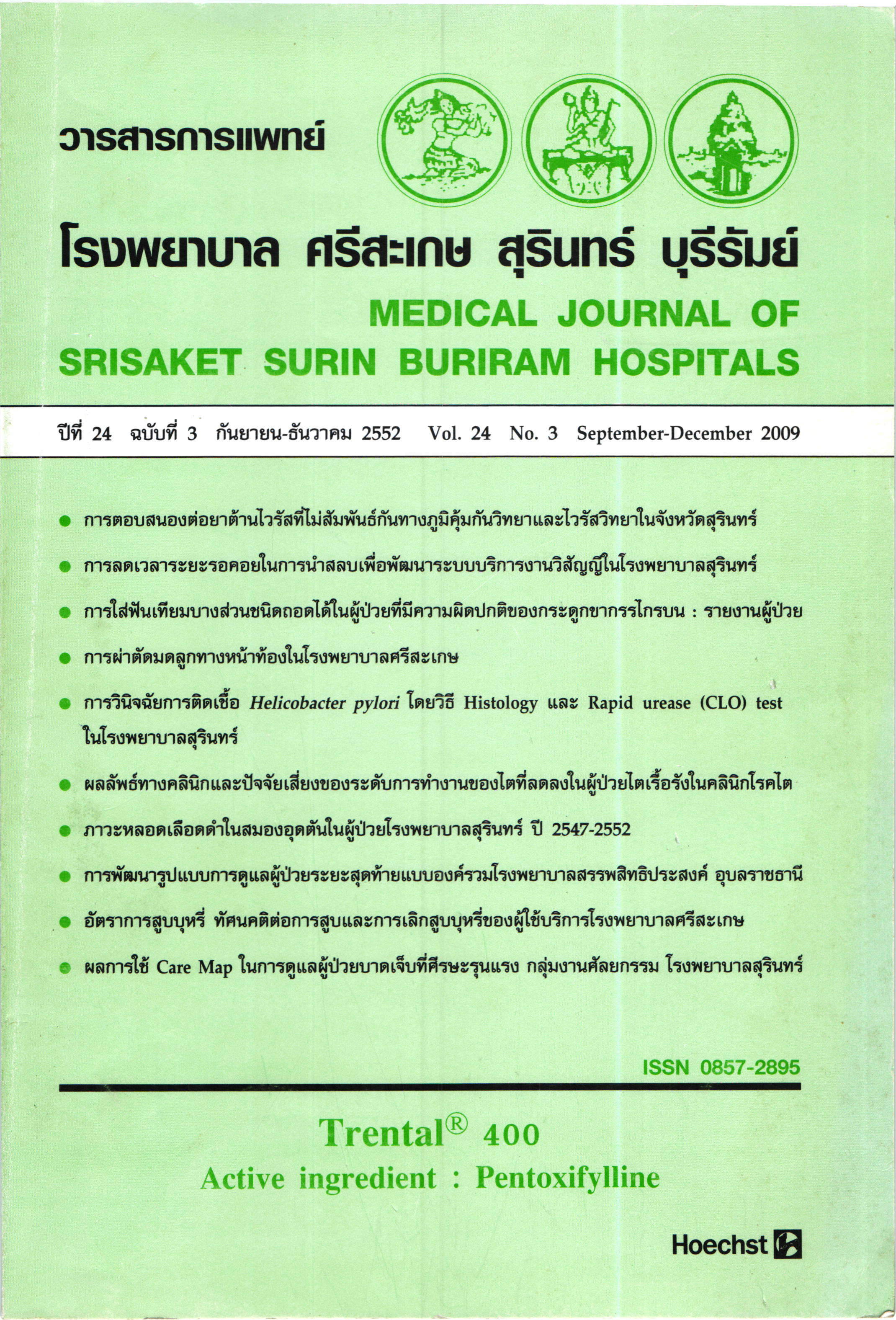การตอบสนองต่อยาต้านไวรัสที่ไม่สัมพันธ์กัน ทางภูมิคุ้มกันวิทยาและไวรัสวิทยาในโรงพยาบาลสุรินทร์
Main Article Content
บทคัดย่อ
วัตถุประสงค์: เพื่อศึกษาผลการตอบสนองที่ไม่สัมพันธ์กันระหว่างปริมาณเม็ดเลือดขาวชนิดชีตีสี่กับปริมาณไวรัสในกระแสเลือดของผู้ติดเชื้อเอดส์ในจังหวัดสุรินทร์
รูปแบบการวิจัย: การวิจัยย้อนหลังเชิงพรรณนา
สถานที่ทำการวิจัย: โรงพยาบาลสุรินทร์ จังหวัดสุรินทร์
ผู้ป่วยและวิธีการศึกษา: ทำการศึกษาย้อนหลังเชิงพรรณนา จากผลบันทึกการตรวจวิเคราะห์ชีดีสี่และ ปริมาณไวรัสของงานภูมิคุ้มกันวิทยาคลินิก กลุ่มงานพยาธิวิทยาคลินิก โรงพยาบาล สุรินทร์
ผลการศึกษา: การศึกษานี้ได้ทำการรวบรวมข้อมูลการตอบสนองที่ไม่สัมพันธ์กันระหว่างปริมาณเม็ดเลือดขาวชนิดซีดีสี่กับปริมาณไวรัสในกระแสเลือดที่มีอยู่ศึกษาเปรียบเทียบ กับข้อมูลอื่นเพื่อหาแนวทางที่ดีต่อการักษาผู้ติดเชื้อ พบความไม่สัมพันธ์กันทางภูมิคุ้มกัน วิทยา ร้อยละ 8, การรักษาไม่ประสบผลสำเร็จร้อยละ 5, ความไม่สัมพันธ์กันทางไวรัสวิทยาร้อยละ 10, และการรักษาประสบความสำเร็จร้อยละ 77, สรุปได้ว่าจำนวนผู้ติดเชื้อเอชไอวีและการพัฒนาการของโรคเอดส์มีความสัมพันธ์กับความสำเร็จในการรักษาผู้ติดเชื้อเอชไอวีในแต่ละท้องถิ่น
สรุป: จำนวนผู้ติดเชื้อเอชไอวีและการพัฒนาการของโรคเอดส์มีความสัมพันธ์กับความสำเร็จในการรักษาผู้ติดเชื้อเอชไอวีในแต่ละท้องถิ่น
คำสำคัญ: การตอบสนองทีไม่สัมพันธ์กัน, ปริมาณเม็ดเลือดขาวชนิดชีดีสี, ปริมาณไวรัส
Article Details
เอกสารอ้างอิง
Gulick RM, Mellors JW, Havir D et al. Treatment with indinavir, zidavudine and lamivudine in adults with human immunodeficiency virus infection and prior antiretroviral therapy. N Engl J Med 1997;337:734-9.
Hammer SM. Squires KE, Hughes MD et al. A controlled trial of two nucleoside analogues plus indinavir in persons with humen immunodeficiency virus infection and CD4 cell count of 200 per cubicmillimeter or less AIDS Clinical Trials Group 320 Study Team. N Engl J Med 1997 ; 337 : 725-33.
Montaner JS, Reiss P, Cooper D et al. A randomizied, double-blind trial comparing combinations of nevirapine, didanosine and zidovudine for HIV- infected patients ; the INCAS trial. Italy, The Netherlands, Cannada and Australia Study. JAMA 1998 ; 279-930-7.
Mootr DM, Hogg RS, Yip B et al. Discordant immunologic and virologic responses to highly active antiretroviral therapy are associated with incressed mortality and poor adherence to therpy. J Acquir immune Defic Syndr 2005;40:288-93.
Piketty C, Castiel P, Beiec L et al. Discrepant responses to tripie combination antiretroviral therapy in advanced HIV disease. AIDS 1998;12:745-50.
Schechter M, Brinkhof M et al. Discordant immunologic and virologic responses to ART among previously na®ve adults initiating HAART in resource-constrained settings. In : Programs and Abstracts of the thirteenth Conference on Retroviruses and Opportunistic infections, Denver, 2006. Abstract 559. p 229. Alexandra, VA, USA : Foundation for Retrovirology and Human Health.
สักดึ๋ซัย เด'ยตรัยรัตน์, Discordant responses in patients being treated in Chiang Mai. การประขุมวิชาการเอดส์และโฟไซโทรเมทรี ประ3าปี พ.ศ.2551. ครั้งที่ 14 หน้า 3.
De Mendoza C, Koppelman M, Montes B et al. Multicenter evaluation of the NucliSens Easy Q HIV-lvl.l assay for the quantitative detection of HIV-1 RNA in plasma. J Virol Methods. 2005 jul ; 127(1):54-9.
Grabar S, Le Moing V, Goujard C et al. Clinical outcome of patients with HIV-1 infection according to immunology and virology response after 6 months of highly active antiretroviral therapy. Ann intern Med 2000;133:401-10.
Pikette C, Castiel P, Belec L et al. Long-term evaluation of T-cell subsets and T-cell function after HAART in advanced stage HIV-1 disease. AIDS 1999 ; 13: 1187-93.
Ameisen JC. Programmed cell death and AIDS : from hypothesis to experiment. Immunol Today 1992 ; 13 : 388-91.
Ameisen JC. The origin of programmed cell death. Science 1996 ; 272 : 1278-9.


